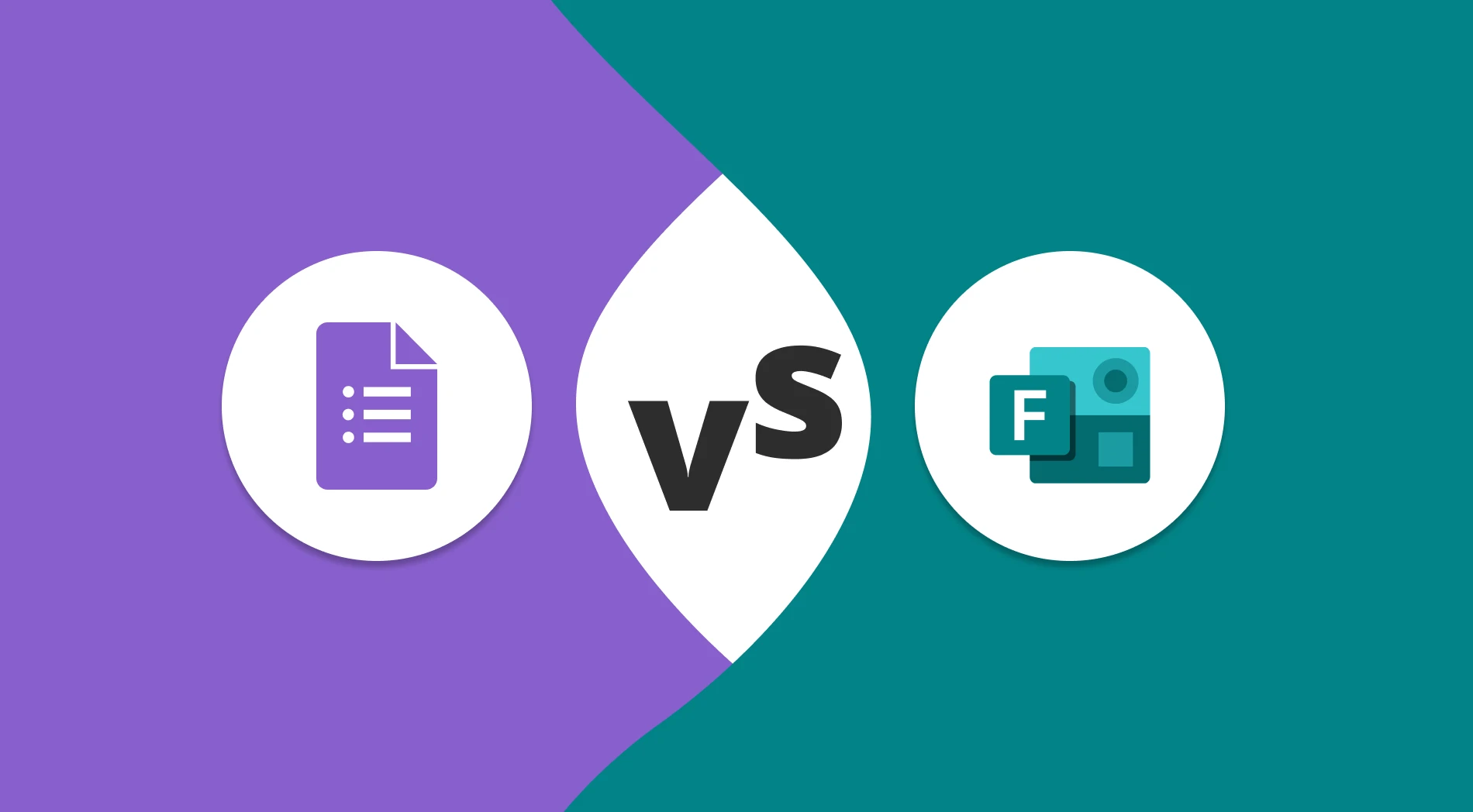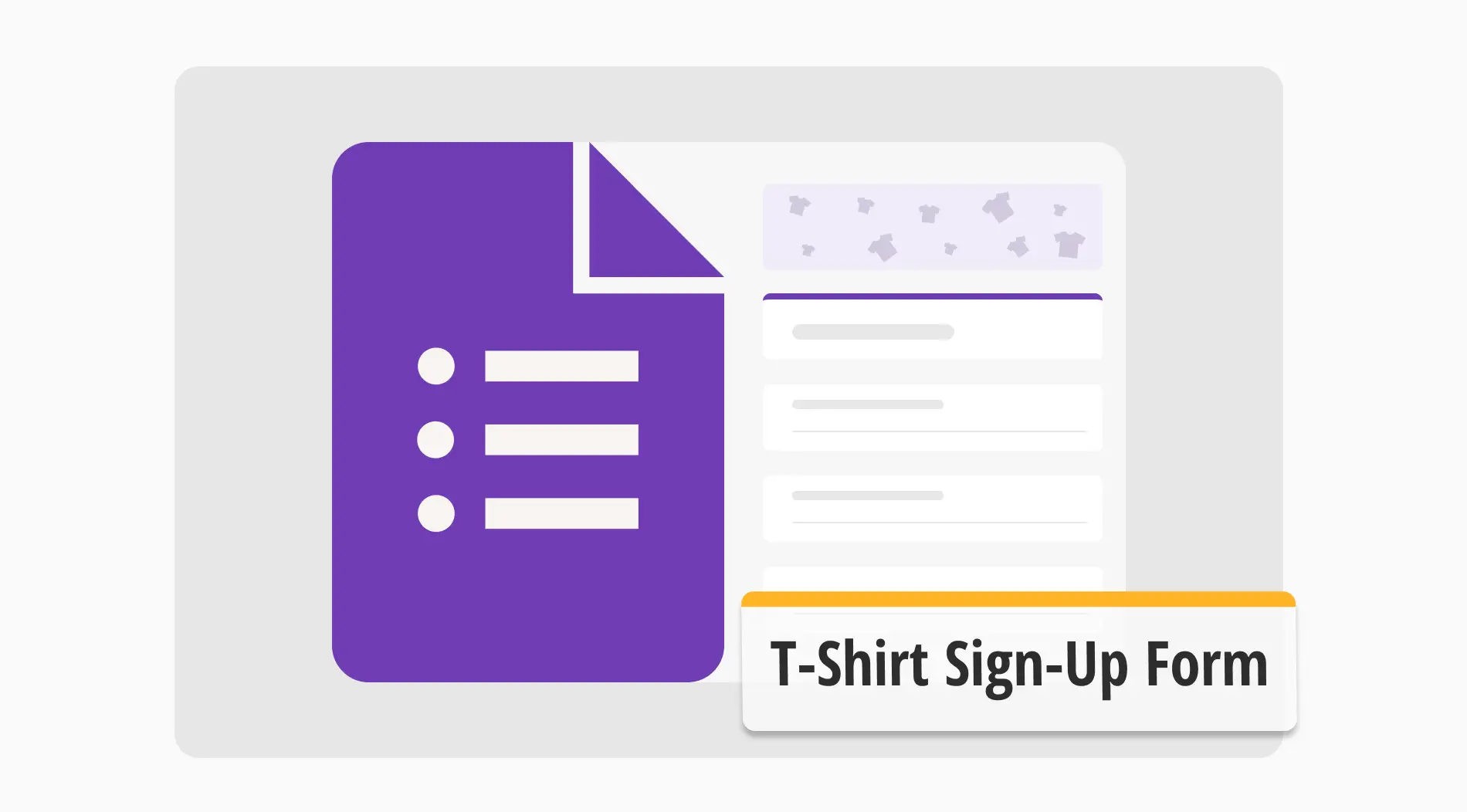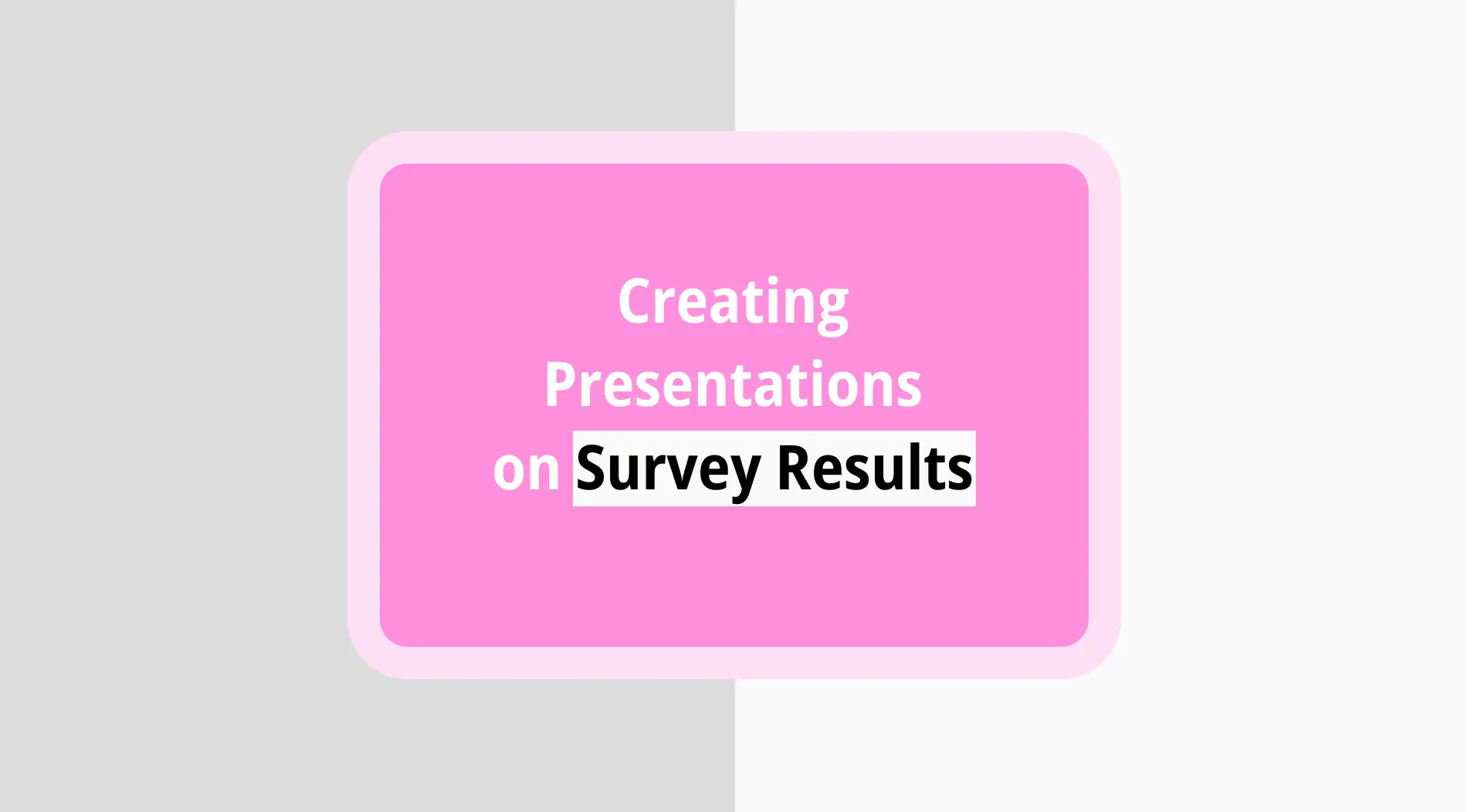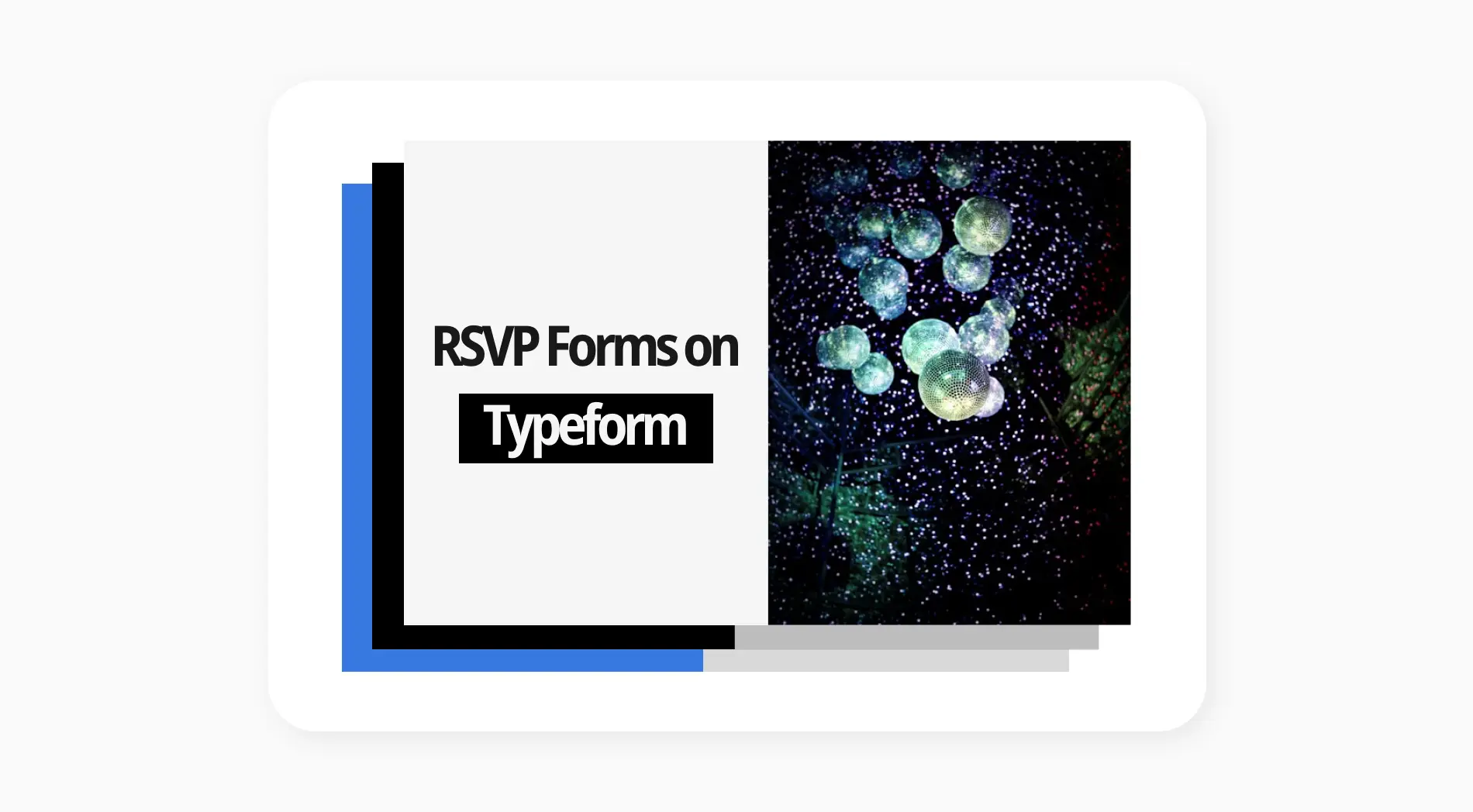La gestion d'une entreprise aujourd'hui nécessite la création et la gestion de divers documents essentiels en ligne. Cela inclut les candidatures, les évaluations, les commandes en ligne, les formulaires d'enquête et la collecte de paiements en temps réel. Si vous êtes familier avec les plateformes de création de formulaires en ligne, vous savez à quel point elles peuvent être utiles pour la collecte de données. Une application puissante peut changer la donne dans la création de formulaires et l'analyse ultérieure de vos réponses.
Lorsque l'on pense aux documents en ligne, la première chose qui vient à l'esprit sont généralement des formulaires comme Google Forms. Pour quelqu'un qui commence tout juste, ce service peut sembler être le choix le plus facile. Cependant, vous pourriez être surpris du nombre d'autres plateformes offrant de meilleures interfaces et fonctionnalités. Dans cet article, nous avons préparé une comparaison de deux outils populaires : Google Forms vs Microsoft Forms.
Google Forms vs Microsoft Forms : quel outil est meilleur ?
Trouver une alternative à Google Forms n'est pas difficile, grâce aux nombreuses applications disponibles. Le concurrent d'aujourd'hui est Microsoft Forms, qui est en fait assez similaire au précédent en raison de nombreux facteurs. Aujourd'hui, nous allons explorer les capacités de ces deux outils, et vous serez celui qui choisira le meilleur ou peut-être optera pour une alternative supérieure.
Google Forms vs Microsoft Forms à première vue
Comme mentionné précédemment, ces deux plateformes sont utilisées non seulement pour créer des formulaires web, mais certaines de leurs fonctionnalités se ressemblent beaucoup. Elles incluent le prix, les options de personnalisation et la variété de modèles. Il n'y a pas de précipitation ; nous allons analyser tous les détails un peu plus tard. Pour l'instant, considérez un regard général sur ce que sont ces outils et comment ils peuvent bénéficier à votre entreprise :
Google Forms crée un espace en ligne convivial pour la collecte de données grâce à des formulaires personnalisables. En tant que partie de Google Workspace, cette application web est accessible sur n'importe quelle plateforme, ce qui la rend polyvalente pour divers besoins, notamment les entreprises, l'éducation et l'utilisation personnelle. Google Forms permet aux utilisateurs de créer des formulaires, d'ajuster les types et les champs de questions, et de collecter sans effort les réponses dans Google Sheets.
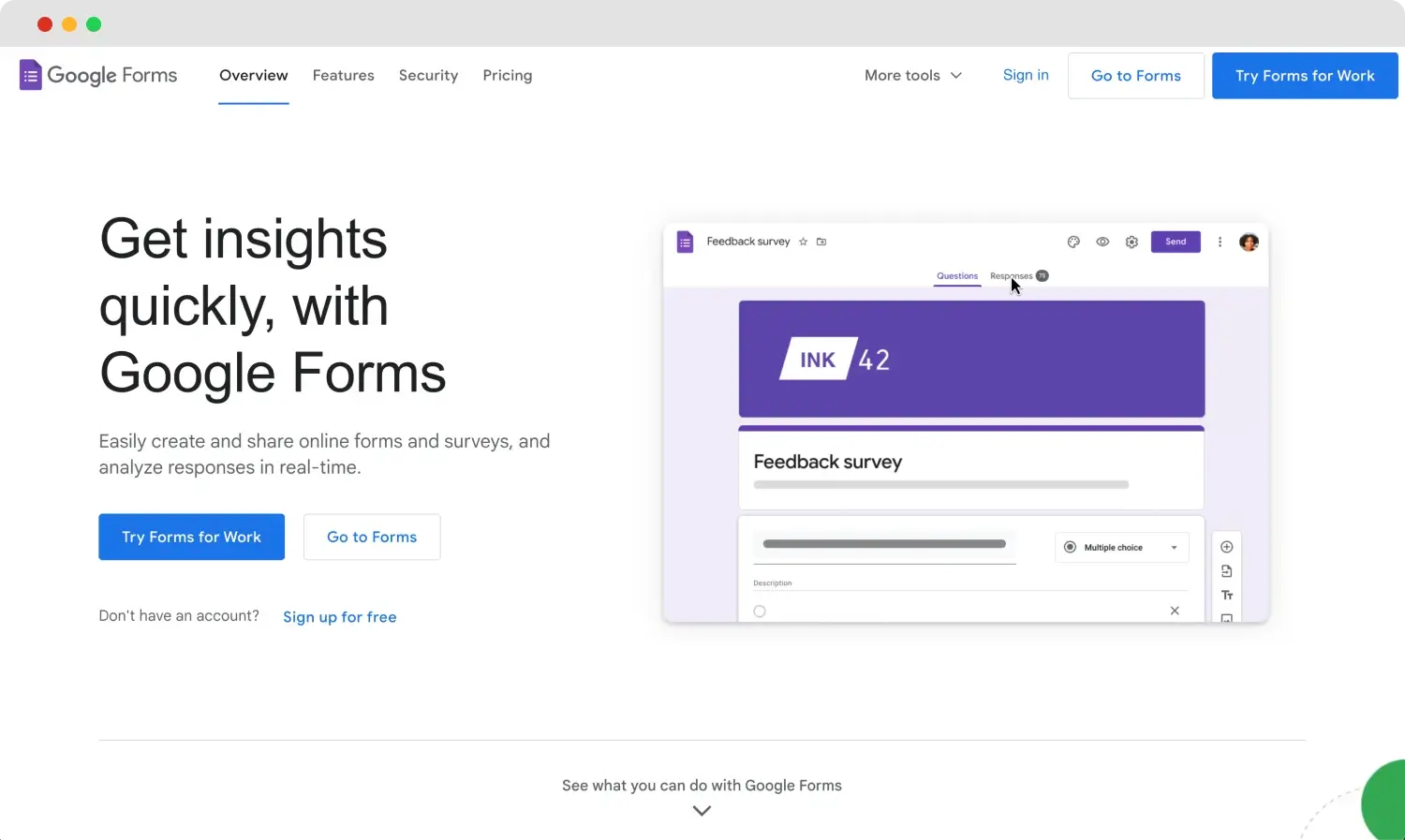
La page d'accueil de Google Forms
Microsoft Forms est un outil de création de formulaires en ligne convivial inclus dans le logiciel Microsoft 365. Il simplifie la création de formulaires, aidant les utilisateurs à collecter des données pour des enquêtes, des sondages, des commentaires et la planification d'événements. Avec son design intuitif et ses fonctionnalités adaptées aux entreprises, Microsoft Forms rationalise le processus de création de formulaires, y compris des outils alimentés par l'IA et des recommandations de questions.
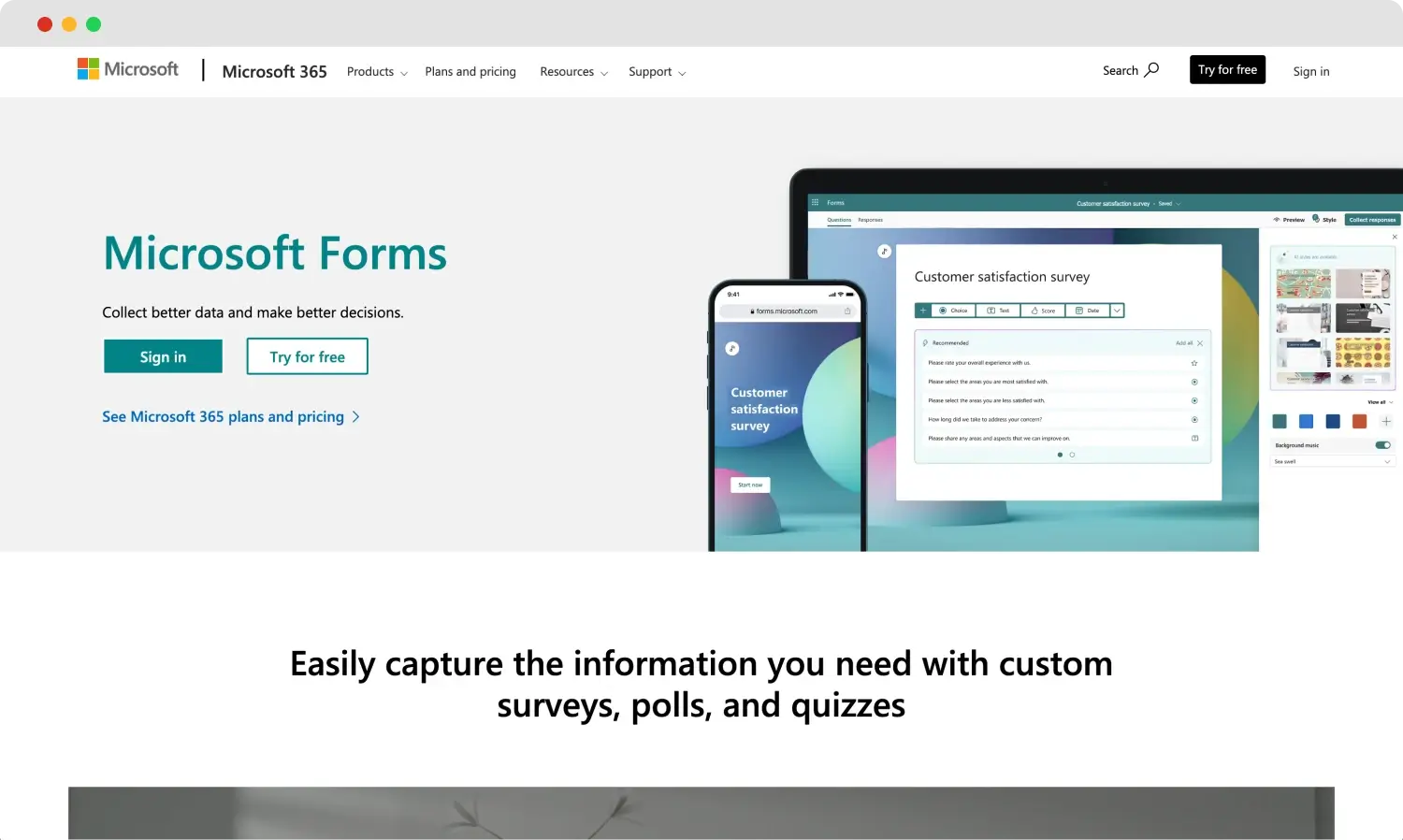
La page d'accueil de Microsoft Forms
Si vous êtes intéressé par explorer quelque chose de plus avancé, nous avons un outil qui pourrait attirer votre attention. forms.app est la meilleure alternative à Google Forms, et en plus, c'est un concurrent solide à d'autres applications comme Microsoft Forms. Il offre toutes les fonctionnalités essentielles et des fonctionnalités innovantes alimentées par l'IA pour créer des formulaires et des documents. De plus, il convient aux entreprises de toutes tailles et de tous types.
Google Forms vs. Microsoft Forms: 7 points essentiels
Lors de la sélection d'un créateur de formulaires pour votre entreprise, vous devez prendre en compte des facteurs tels que sa bibliothèque de modèles, sa convivialité, et si le plan tarifaire est plus adapté aux grandes organisations ou aux petites entreprises. Ci-dessous, vous pouvez examiner chaque point important étape par étape pour en savoir plus sur Google Forms et Microsoft Forms, vous aidant à prendre une meilleure décision:
1. Tarification
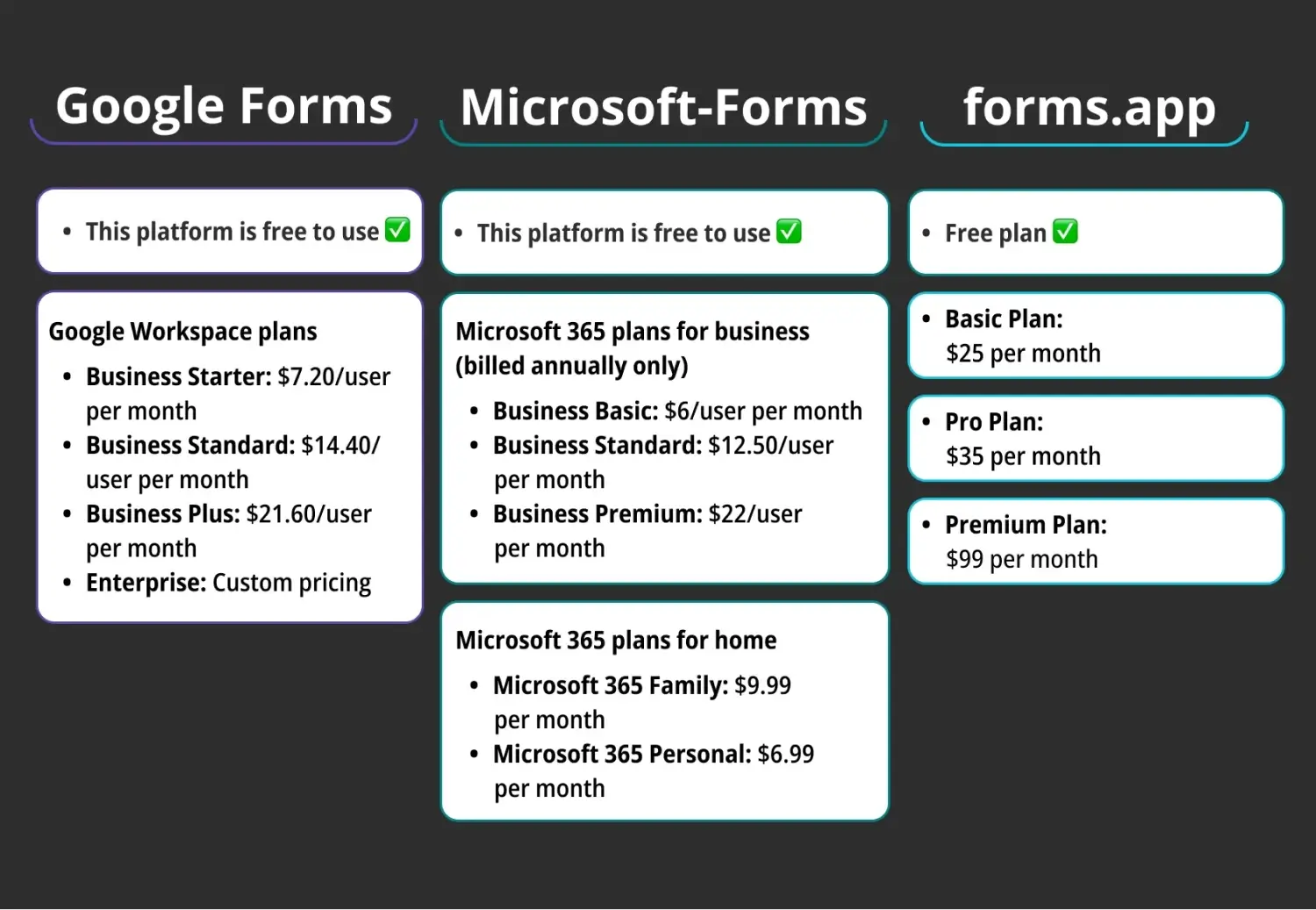
Comparaison des prix entre Google Forms, Microsoft Forms et forms.app
Notre premier outil est en fait gratuit à utiliser. L'accès gratuit rend Google Forms idéal pour une utilisation personnelle. Cependant, si vous êtes un utilisateur professionnel, vous voudrez vous inscrire à Google Workspace. Ce plan tout-en-un comprend Google Forms ainsi que d'autres applications telles que Gmail, Google Drive, Google Calendar, et Google Sheets. Voici les plans tarifaires de Google Forms:
Cette plateforme est gratuite à utiliser✅
Les plans Google Workspace
- Starter d'entreprise: 7,20 $/utilisateur par mois
- Standard d'entreprise: 14,40 $/utilisateur par mois
- Plus d'entreprise: 21,60 $/utilisateur par mois
- Entreprise: Tarification personnalisée
De même, l'accès à Microsoft Forms est gratuit, ne nécessitant qu'un compte Microsoft, mais vient avec des options et des fonctionnalités limitées. Pour les besoins professionnels, vous aurez besoin d'un plan Microsoft 365 Business actif, qui inclut des applications comme Word, Excel, et Outlook. Microsoft Forms est disponible sur tous les plans Microsoft 365, sauf Microsoft 365 Apps pour les entreprises. Voici les plans de tarification de Microsoft Forms:
Cette plateforme est gratuite à utiliser✅
Plans Microsoft 365 pour les entreprises (facturés annuellement uniquement)
- Basique d'entreprise: 6 $/utilisateur par mois
- Standard d'entreprise: 12,50 $/utilisateur par mois
- Premium d'entreprise: 22 $/utilisateur par mois
Plans Microsoft 365 pour la maison
- Microsoft 365 Famille: 9,99 $ par mois
- Microsoft 365 Personnel: 6,99 $ par mois
En parlant de fantastiques alternatives, forms.app offre un plan gratuit qui fournit un accès à toutes les fonctionnalités, les modèles de formulaire, et les champs de formulaire. Ses plans de tarification commencent à 25 $ par mois, ce qui le rend abordable même pour les petites entreprises. Explorez ses options de tarification ci-dessous et voyez par vous-même que forms.app mérite certainement d'être pris en compte:
- Plan gratuit ✅
- Plan de base: 25 $ par mois
- Plan Pro: 35 $ par mois
- Plan Premium: 99 $ par mois
2. Fonctionnalités du formulaire
En arrivant au point suivant, Google Forms offre un constructeur glisser-déposer et des types de questions pré-construits, permettant une construction rapide de formulaires. Vous pouvez rendre les questions obligatoires, garder les sondages anonymes, et contrôler l'accès des répondants. De plus, les utilisateurs peuvent exporter les données vers Google Sheets ou les utiliser comme fichiers. Cependant, Google Forms n'est disponible qu'en ligne, ce qui pose problème sans une connexion fiable.
En revanche, Microsoft Forms excelle dans la création de sondages, quiz, et enquêtes avec des outils alimentés par l'IA et la fonction Form Ideas pour améliorer vos formulaires. Il prend en charge les formulaires multilingues et la logique de branches, guidant les répondants vers les questions pertinentes en fonction de leurs réponses. De plus, l'exportation des soumissions de formulaire vers Microsoft Excel pour l'analyse est simple, rendant la gestion des données sans faille.
Si vous avez besoin d'options plus avancées, forms.app offre un éditeur glisser-déposer intuitif avec différents types de champs. Il comprend une Vue étape pour les sondages et quiz et une Vue liste pour les formulaires avec toutes les questions sur une seule page. Il y a une fonction Conditions pour les formulaires plus complexes, un Calculateur pour les formulaires nécessitant des calculs, et une fonction Restriction de géolocalisation.
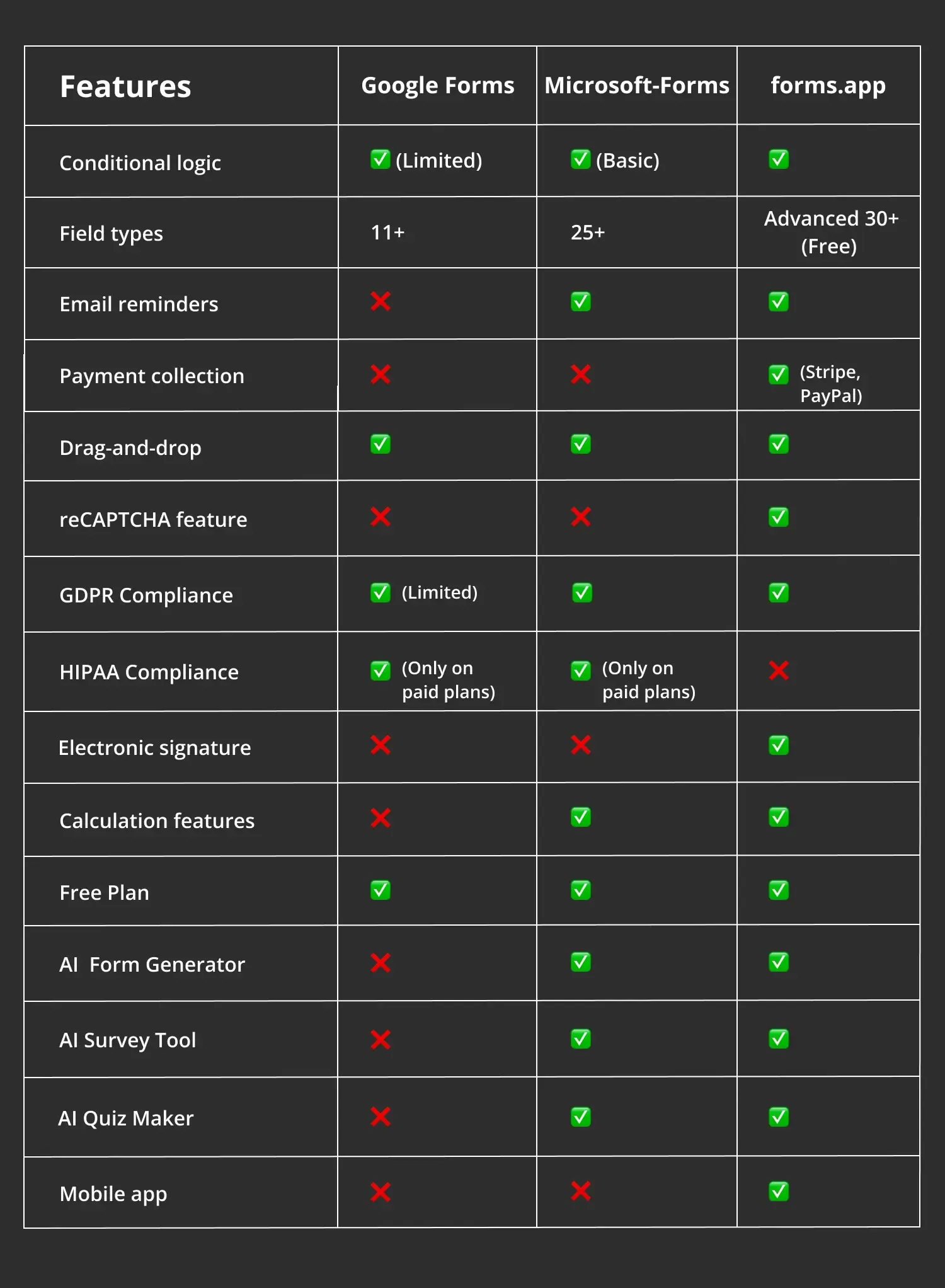
Comparaison des fonctionnalités entre Google Forms, Microsoft Forms et forms.app
3. Options de personnalisation
Google Forms et Microsoft Forms offrent tous deux des options de personnalisation de base. Vous pouvez personnaliser les formulaires avec votre logo d'entreprise, des images personnalisées, et des thèmes de couleurs pour correspondre à votre image de marque. Avec Google Forms, vous êtes libre d'ajuster les images d'en-tête, les polices, et les couleurs, tandis que Microsoft Forms offre des thèmes alimentés par l'IA et vous permet de définir des thèmes de couleurs, d'ajouter des logos, et de personnaliser les arrière-plans.
Pour des formulaires vraiment attrayants et professionnels, pensez à forms.app. Il vous permet non seulement de personnaliser le thème, les éléments, les polices et les couleurs de votre formulaire, mais également de choisir un type de vue pour une meilleure interaction. Des fonctionnalités innovantes telles que Rewrite with AI peuvent améliorer votre formulaire en quelques secondes. De plus, forms.app propose des arrière-plans animés, du CSS personnalisé et même des téléchargements vidéo en tant que média de champ.
4. Types de champs
Google Forms propose plus de 11 types de champs différents, notamment des réponses longues, des réponses courtes, des choix multiples, des cases à cocher, et bien plus encore. Vous pouvez également insérer des menus déroulants, des matrices de choix multiples, des matrices de cases à cocher et des champs de téléchargement de fichiers. De plus, vous pouvez inclure des résumés ou des notes et fournir vos réponses proposées pour une expérience de construction de formulaire complète.
Microsoft Forms dispose également d'une gamme de types de champs pour vous aider à créer des formulaires ou des enquêtes répondant à vos besoins essentiels. Ceux-ci incluent Choix, Texte, Évaluation, Date, Classement, Échelle de Likert et Téléchargement de fichiers. De plus, Microsoft Forms fournit des questions préfabriquées sur le score Net Promoter ainsi que des formats de questions de notation et de classement pour des formulaires complets et diversifiés.
Lorsque vous choisissez des types de champs, il est essentiel de choisir un constructeur de formulaires qui offre une variété d'options. forms.app propose tous les champs essentiels et uniques pour de nombreuses utilisations. Il offre une polyvalence avec plus de 30 champs innovants tels que Panier de produits, Champ de dessin et Champ de paiement. Le meilleur, c'est que vous pouvez accéder à toutes les options avec le plan gratuit.
5. Intégrations
Google Forms s'intègre parfaitement à l'ensemble de la suite Google de produits. Vous pouvez également connecter facilement votre formulaire à une feuille Google en un seul clic ou enregistrer vos données sous forme de fichier .csv pour une utilisation ultérieure dans d'autres applications. Avec Google Workspace, les utilisateurs peuvent lier différentes feuilles, formulaires et documents pour créer un flux de travail de bout en bout facile à gérer.
Bien que Microsoft Forms s'intègre parfaitement avec la Suite Microsoft, y compris Outlook, Microsoft Excel, OneDrive, Microsoft Teams, et d'autres applications, il offre moins d'intégrations que prévu pour une plateforme de création de formulaires solide. Malgré son intégration forte au sein de l'écosystème Microsoft, les utilisateurs peuvent avoir besoin d'aide pour se connecter avec des outils externes et des applications tierces.
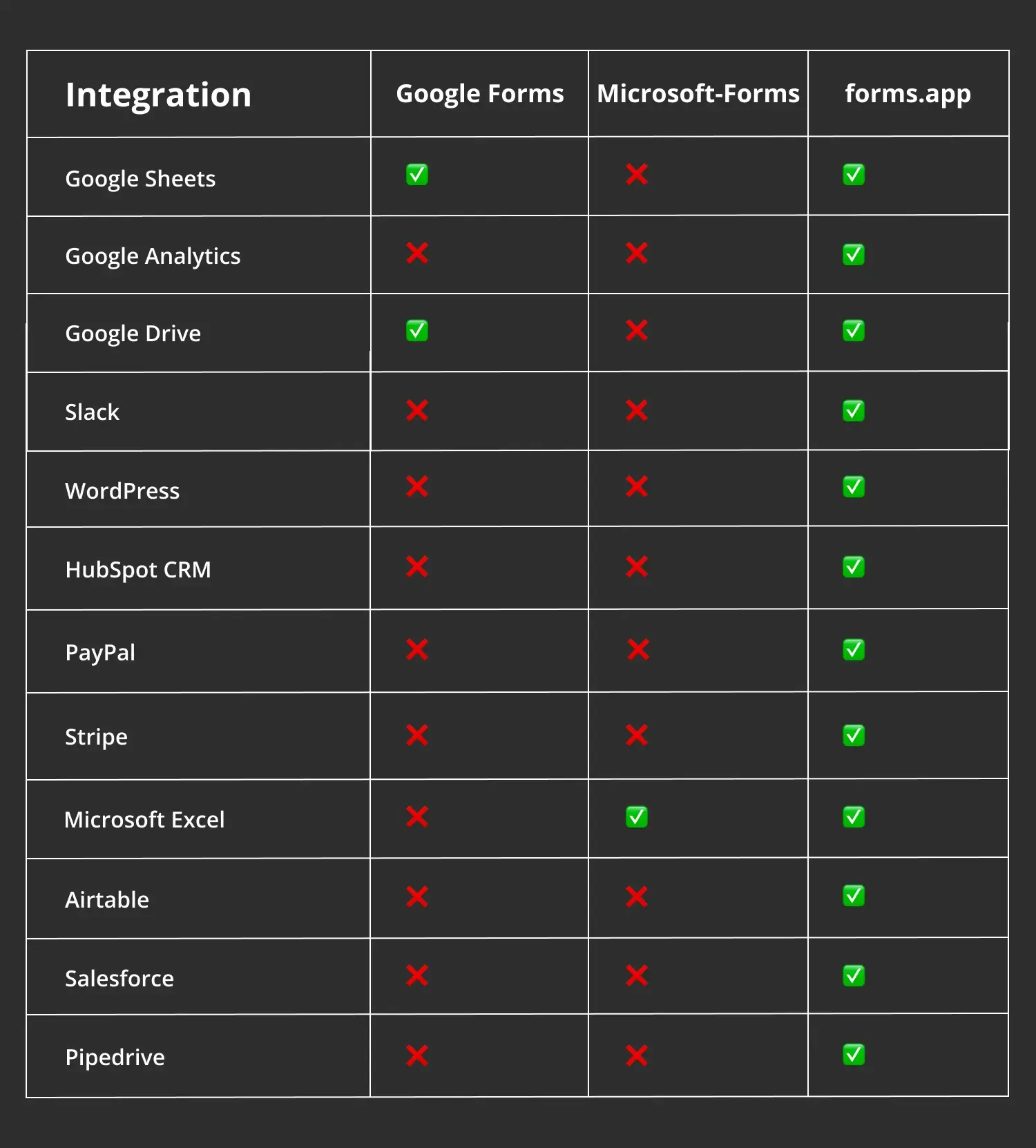
Comparaison d'intégration entre Google Forms, Microsoft Forms et forms.app
6. Collaboration en équipe
Google Forms dispose de fonctionnalités de collaboration standard, vous permettant d'inviter d'autres personnes à collaborer sur votre formulaire ou de travailler dessus vous-même. Lorsque vous partagez un formulaire Google avec un collaborateur, vous lui donnez un accès complet en modification, lui permettant de faire les modifications nécessaires, y compris collecter des réponses. Ces options peuvent grandement bénéficier à votre travail en offrant une collaboration fluide et des capacités de modification en temps réel.
Avec Microsoft Forms, vous pouvez partager des liens de sondage, envoyer des invitations par e-mail, ou créer des codes QR pour une connexion rapide. L'intégration avec Microsoft Teams et SharePoint simplifie l'édition collaborative au sein de l'écosystème Microsoft 365. Les utilisateurs peuvent collaborer en temps réel avec leurs collègues ou camarades de classe, toutes les modifications étant visibles pour tout le monde. Dans l'ensemble, la plateforme offre des options de partage, facilitant le travail d'équipe sur le même document.
7. Modèles
Google Forms et Microsoft Forms ont tous deux des modèles essentiels pour simplifier la création de formulaires. Google Forms propose une collection de modèles qui fournissent des thèmes et des questions suggérées pour différents besoins, tels que des formulaires de commande et des retours clients. D'autre part, Microsoft Forms présente 20+ modèles, qui sont toujours utiles pour créer des formulaires simples, des inscriptions à des événements, ou des sondages.
Bien sûr, le nombre de modèles dans la bibliothèque de modèles peut accélérer votre travail, et c'est là que forms.app brille. Avec plus de 5000 modèles pour les formulaires, les enquêtes, et les documents, vous avez tellement d'options pré-conçues. Sa collection couvre tous les objectifs, des formulaires de contact et d'évaluation de base aux enquêtes de recherche de marché complexes. De plus, ces modèles sont disponibles dans plusieurs langues.
Une meilleure alternative: forms.app
En concluant notre comparaison ultime entre Google Forms et Microsoft Forms, vous avez peut-être remarqué que chaque outil a ses propres spécificités à prendre en compte lors du choix pour votre entreprise. Cependant, il est important de noter que ce ne sont pas les seules options sur le marché. Permettez-nous maintenant de vous fournir plus d'informations sur une alternative incroyable.
forms.app est un constructeur de formulaires en ligne robuste conçu pour les entreprises de toutes tailles. Il offre toutes les fonctionnalités avancées pour rationaliser la création de formulaires, d'enquêtes, et de quiz. Quel que soit votre objectif, sa plateforme intuitive est idéale pour collecter facilement des données précieuses. De plus, les outils innovants basés sur l'IA de forms.app ne manqueront pas de susciter votre intérêt. Voici toutes les fonctionnalités clés:
- Interface conviviale: Que vous soyez débutant ou expert, l'éditeur de formulaires par glisser-déposer de forms.app rend la création de formulaires intuitive et sans effort, garantissant des résultats professionnels à chaque fois.
- Modèles pré-prêts: Vous pouvez explorer plus de 5000 modèles pré-conçus adaptés à divers domaines et besoins. Ces modèles offrent des solutions pour tous vos besoins en matière de création de formulaires, garantissant commodité et efficacité.
- Outils puissants basés sur l'IA: forms.app dispose de fonctionnalités alimentées par l'IA telles que Générateur de formulaires IA, Outil d'enquête IA, et Créateur de quiz IA. Ces outils utilisent la technologie de l'IA pour rationaliser votre flux de travail, vous faisant gagner du temps et des efforts.
- Intégrations: forms.app se connecte avec des applications tierces populaires telles que Slack, HubSpot, WordPress, Stripe, PayPal et Google Drive. Cette option utile améliore la connectivité et augmente la productivité de votre équipe de travail.
- Accessibilité mobile: Avec l'application mobile de forms.app, disponible sur Google Play Store et Apple Store, vous pouvez facilement créer des formulaires en déplacement. Cela vous permet et permet à votre équipe de maintenir la productivité sur les ordinateurs de bureau et les appareils mobiles.
Mots de fin
En conclusion, Google Forms est parfait pour les débutants avec son interface simple, personnalisation de base et abordabilité. Pour ceux qui préfèrent les produits Microsoft, Microsoft Forms convient aux petites entreprises avec son plan gratuit et offre plus de fonctionnalités pour les grandes entreprises grâce à ses plans professionnels. Il comprend également des outils d'analyse et des options d'IA, répondant aux différents besoins des entreprises.
Dans cette comparaison détaillée de Google Forms et Microsoft Forms, nous espérons avoir clarifié quelle plateforme pourrait être la meilleure pour vous. N'oubliez pas, lors du choix, de prendre en compte des facteurs tels que le prix, l'interface et les fonctionnalités spécifiques du formulaire. En prêtant attention à ces éléments, vous pouvez sélectionner le meilleur outil pour vos besoins ou même envisager une alternative convaincante.
forms.app, ton créateur de formulaires gratuit
- Nombre illimité de vues
- nombre illimité de questions
- nombre illimité de notifications
